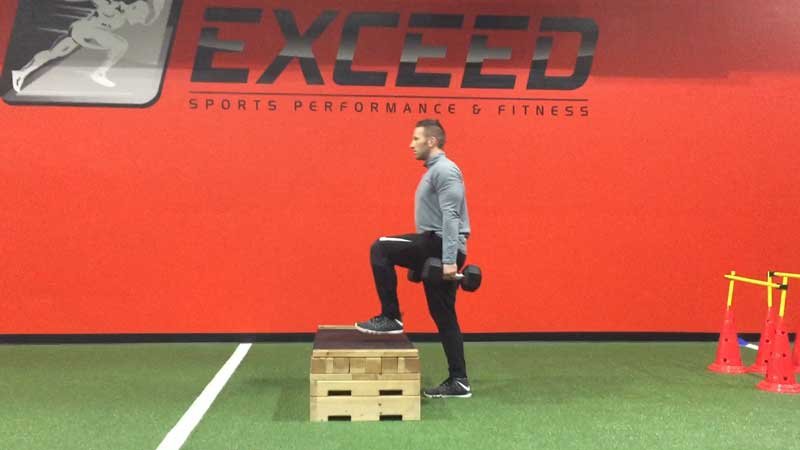Step-ups are an excellent lower body exercise that primarily targets the quadriceps, hamstrings, and glutes while engaging your calves and core muscles. This versatile exercise not only builds strength but also improves balance and stability. In this comprehensive guide, we’ll explore the benefits of step-ups, provide step-by-step instructions on how to perform them correctly, highlight common mistakes to avoid, introduce variations to challenge yourself, and suggest alternative exercises for a well-rounded leg workout routine.
Muscles Worked
- Primary Muscles:
- Quadriceps (front thigh muscles)
- Hamstrings (back thigh muscles)
- Gluteus Maximus (buttocks)
- Secondary Muscles:
- Calves (gastrocnemius)
- Core muscles (for stability)
How to Do Step-Ups
Follow these steps to execute step-ups correctly:
Equipment Needed: A sturdy bench, box, or step platform
- Starting Position:
- Stand in front of the bench or platform with your feet hip-width apart.
- Keep your chest up, shoulders back, and core engaged for stability.
- Step Onto the Bench:
- Place your right foot flat on the bench, ensuring it’s entirely on the surface.
- As you step up, push through your right heel and engage your quadriceps and glutes.
- Fully Extend the Right Leg:
- Stand up straight by fully extending your right leg and lifting your body onto the bench.
- Keep your chest up and shoulders back throughout this motion.
- Balance and Control:
- Pause briefly at the top to balance yourself.
- Ensure your left foot remains off the bench and slightly behind you.
- Step Down:
- Slowly lower your body by bending your right knee and hip.
- Gently tap your left toes on the floor behind you for balance.
- Repeat:
- Now, perform the same movement with your left foot stepping onto the bench.
- Alternate between legs for the desired number of repetitions.
- Maintain Form:
- Keep your torso upright and avoid leaning forward.
- Perform the exercise with a smooth and controlled motion.
- Repetitions and Sets:
- Aim for 10-12 repetitions per leg for 2-3 sets.
Benefits of Step-Ups
Incorporating step-ups into your leg workout routine offers several benefits:
- Leg Strength: Targets and strengthens the major leg muscles, including the quadriceps, hamstrings, and glutes.
- Functional Fitness: Enhances leg strength for everyday activities such as climbing stairs, walking, and running.
- Balance and Coordination: Challenges your balance and coordination as you step up and down.
- Core Engagement: Engages your core muscles to stabilize your body during the exercise.
- Calorie Burn: Burns calories and contributes to weight management due to its compound nature and muscle engagement.
- Variety: Adds variety to your leg workout routine, preventing workout plateaus.
Common Mistakes to Avoid
To maximize the effectiveness of step-ups and reduce the risk of injury, be mindful of these common mistakes:
- Incomplete Range of Motion: Ensure you fully extend your stepping leg at the top of the motion, standing up straight.
- Rushing: Maintain control throughout the exercise rather than rushing through the movement.
- Neglecting Core Engagement: Keep your core muscles engaged to stabilize your body and protect your lower back.
- Using Excessive Height: Start with a lower bench or platform if you’re new to step-ups. Gradually increase the height as you become more proficient.
Variations of Step-Ups
To add variety to your leg workout and target different muscle groups, consider these step-up variations:
- Weighted Step-Ups: Hold dumbbells or a weighted barbell to increase resistance and challenge your upper body.
- Box Jumps: Perform explosive step-ups, jumping onto the bench or platform and then back down. This variation adds a plyometric element to your workout.
- Lateral Step-Ups: Step onto the bench from the side to engage your inner and outer thighs.
Alternative Exercises
If you’re looking to diversify your lower body workout, consider these alternative exercises:
- Lunges: Forward, reverse, or lateral lunges target similar muscle groups and can be performed without equipment.
- Squats: A classic lower body exercise that engages the quadriceps, hamstrings, and glutes.
- Leg Press: Performed on a leg press machine, it emphasizes leg and glute strength.
Incorporating step-ups and their variations into your leg workout routine can help you develop strong and toned legs while improving your balance and stability. Remember to maintain proper form, start with a comfortable bench height, and gradually increase the difficulty as you become more proficient in the exercise.
